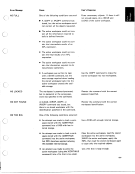Dyadic (Two-Argument) Form: Minimum A LB
The minimum function result is the smaller of the arguments. The arguments can be
numeric scalars, vectors, or other arrays. The arguments must be the same shape un-
less one of the arguments is a scalar or any single-element array. Arguments of the
same shape have the same shape result:
If one argument is a scalar or a single-element array, the shape of the result is the
same as that of the other argument. The single element is applied to every element
of the multielement array:
a
The I Function: Magnitude, Residue
Monadic (One-Argument) Form: Magnitude I B
The magnifude function result is the absolute value of the argument. The argument
can be a numeric scalar, vector, or other array. The shape of the result is the same
as that of the argument:
If the argument is an array, the function is extended to each of the elements:
52
The minimum function result is the smaller of the arguments. The arguments can be
numeric scalars, vectors, or other arrays. The arguments must be the same shape un-
less one of the arguments is a scalar or any single-element array. Arguments of the
same shape have the same shape result:
If one argument is a scalar or a single-element array, the shape of the result is the
same as that of the other argument. The single element is applied to every element
of the multielement array:
a
The I Function: Magnitude, Residue
Monadic (One-Argument) Form: Magnitude I B
The magnifude function result is the absolute value of the argument. The argument
can be a numeric scalar, vector, or other array. The shape of the result is the same
as that of the argument:
If the argument is an array, the function is extended to each of the elements:
52









































































































































































































































